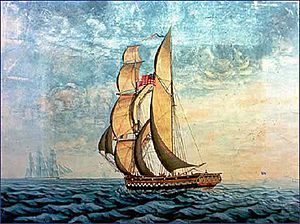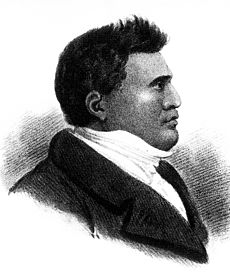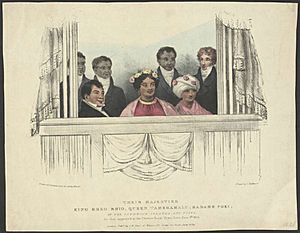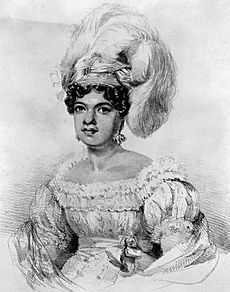Kamehameha II facts for kids
Quick facts for kids Kamehameha II |
|||||
|---|---|---|---|---|---|
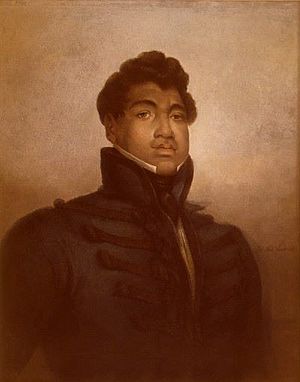
Portrait of Kamehameha II at the ʻIolani Palace
|
|||||
| King of the Hawaiian Islands (more...) | |||||
| Reign | May 20, 1819 – July 14, 1824 | ||||
| Predecessor | Kamehameha I | ||||
| Successor | Kamehameha III | ||||
| Kuhina Nui | Kaʻahumanu I | ||||
| Born | November 1797 Hilo, Hawaiʻi |
||||
| Died | July 14, 1824 (aged 26) London, England |
||||
| Burial | May 11, 1825 Mauna ʻAla Royal Mausoleum |
||||
| Spouse | Kamāmalu Kīnaʻu Kekāuluohi Pauahi Kekauʻōnohi |
||||
|
|||||
| House | House of Kamehameha | ||||
| Father | Kamehameha I | ||||
| Mother | Keōpūolani | ||||
| Signature | |||||
Kamehameha II (born November 1797 – died July 14, 1824) was the second king of the Kingdom of Hawaii. His birth name was Liholiho. When he became king, his full name was Kalaninui kua Liholiho i ke kapu ʻIolani. He later took the longer name Kalani Kaleiʻaimoku o Kaiwikapu o Laʻamea i Kauikawekiu Ahilapalapa Kealiʻi Kauinamoku o Kahekili Kalaninui i Mamao ʻIolani i Ka Liholiho.
Contents
Early Life of King Kamehameha II
Kamehameha II was born in November 1797 in Hilo, on the island of Hawaiʻi. He was the first son of Kamehameha I and his highest-ranking wife, Keōpuolani.
As a baby, Liholiho was cared for by his father's trusted servant, Hanapi. Later, his grandmother, Kekuʻiapoiwa Liliha, took him back. She felt he needed a better diet. Then, Kamehameha I placed him under the care of Queen Kaʻahumanu. She was another wife of Kamehameha I and became Liholiho's official guardian.
A Frenchman named Jean Baptiste Rives arrived in Hawaii when Liholiho was young. Rives taught the young prince some English and French. He became a close friend. Other friends included Charles Kanaʻina, Kekūanāoʻa, and Laʻanui.
Liholiho's full birth name was Kalaninui kua Liholiho i ke kapu ʻIolani. The name Liholiho means "glowing." It was a shorter version of "the great chief with the burning back kapu." The word ʻIolani meant "royal hawk." This was after the Hawaiian hawk (ʻio), whose high flight showed royalty.
Becoming King: Kamehameha II's Ascension
Liholiho officially became king after his father, Kamehameha I, died in May 1819. However, Queen Kaʻahumanu planned to share power with him. When Liholiho sailed to Kailua-Kona, the capital at the time, Kaʻahumanu greeted him. She wore Kamehameha I's royal red cape.
She announced to everyone, "We two shall rule the land." Liholiho was young and did not have much experience. He had no other choice but to agree. Kaʻahumanu became the first Kuhina Nui, which means "co-ruler" or "prime minister," of Hawaii. Kamehameha II took on a more ceremonial role. Kaʻahumanu held most of the administrative power. He chose to be called King Kamehameha II, but he preferred the name ʻIolani.
Kamehameha II's Reign and Changes
Kamehameha II is best known for the ʻAi Noa, which means "free eating." This was the breaking of the old kapu (taboo) system of religious laws. Six months into his rule, he sat with Kaʻahumanu and his mother Keopuolani. They ate a meal together, which was forbidden under the old laws.
After this, the class of priests was ended. Temples (called heiau) and religious images were destroyed.
Kamehameha I had given his war god Kūkaʻilimoku and his temples to his cousin, Kekuaokalani. Kekuaokalani wanted Liholiho to bring back the old Hawaiian religion. He also wanted him to remove Kalanimōkū and Kaʻahumanu from power. Kamehameha II refused.
At the battle of Kuamoʻo on the island of Hawaiʻi, the king's forces won. They were led by Kalanimōkū and had better weapons. This battle ended the last defenders of the old Hawaiian gods and religious practices. The first Christian missionaries arrived in the Hawaiian Islands just a few months later.
Kamehameha II married several women of high rank, as was the custom for Hawaiian kings at that time. He was the last Hawaiian king to practice polygamy. His favorite wife was his half-sister Kamāmalu.
Kamehameha II was known for being impulsive. For example, in November 1820, he bought a royal yacht called Cleopatra's Barge. He paid a huge amount for it: 8,000 piculs of sandalwood, which was worth about $80,000 at the time. The ship needed major repairs by April 1822 because much of its wood had rotted. He paid to have new wood brought from the Pacific Northwest for the repairs. He then renamed his ship Haʻaheo o Hawaiʻi, which means "Pride of Hawaii." After being relaunched in May 1823, the ship was wrecked less than a year later.
In the summer of 1821, Kamehameha II was on a small boat heading to ʻEwa beach. Suddenly, he ordered the boat to cross a dangerous channel all the way to the island of Kauaʻi. They had no compass, maps, or food. They somehow made it to Kauaʻi. The local Chief Kaumualiʻi welcomed the young king. The royal party stayed for over a month. One night, Kamehameha II invited Kaumualiʻi on board the royal yacht. He then suddenly ordered the yacht to sail away in the night. When they returned to Honolulu, he had Kaumualiʻi "marry" Kaʻahumanu. Kaumualiʻi was kept under house arrest until his death.
Fatal Journey to Great Britain
Another of Kamehameha II's trips turned out to be fatal. In April 1822, English missionary William Ellis arrived with a ship called Prince Regent. This ship was a gift from King George IV of Great Britain. Kamehameha II wrote to thank him and asked for closer ties between their countries. He wanted to travel to London, but all his advisors, including Keōpūolani and Kaʻahumanu, were against the idea. After his mother Keōpūolani died in September 1823, he decided to go.
In November 1823, Kamehameha II and Queen Kamāmalu hired the British whaling ship L'Aigle (meaning "the Eagle") to take them to London. Several important chiefs and their companions went with them. These included High Chief Boki and his wife Kuini Liliha, and Naukane, who had already visited America and England.
They arrived in Rio de Janeiro, Brazil, in February 1824. Emperor Pedro I welcomed them. He gave Kamehameha II a special sword decorated with diamonds. In return, Kamehameha II gave him an ʻAhu ʻula, a traditional feather cloak worn by high-ranking people. Queen Kamāmalu received a diamond ring and gave a yellow feather necklace in return.
The Hawaiian group arrived in Portsmouth, England, on May 17, 1824. The next day, they moved into the Caledonian Hotel in London. The British Foreign Secretary, George Canning, assigned Frederick Gerald Byng to help them during their visit. Byng made sure they had proper clothes for all their public appearances.
The local newspapers were curious about their arrival. On May 28, a party was held in their honor with 200 guests. They toured London, visiting Westminster Abbey. The king refused to go inside, saying he did not want to disrespect the British royal burial place. They also went to the opera and ballet.
King George IV planned to meet them on June 21. However, the meeting was delayed because Queen Kamāmalu became ill. The Hawaiian group had caught measles, a disease they had no protection against. They likely caught it during a visit to the Royal Military Asylum on June 5. Queen Kamāmalu died on July 8, 1824. A few days later, on July 14, 1824, the heartbroken Kamehameha II also died.
Large crowds gathered when Kamehameha II was laid in state at the Caledonian Hotel on July 17. The bodies were then kept in the crypt of St Martin-in-the-Fields church. They waited there to be taken back home. Boki took over as the leader of the Hawaiian group. He finally had a meeting with King George IV.
In August 1824, the bodies were returned to Hawaii on a large Royal Navy ship called HMS Blonde. This ship was commanded by Captain George Anson Byron.
The Blonde arrived back in Honolulu on May 6, 1825. Hawaiian royalty gathered for the funeral. The ship's crew held a formal procession. The ship's chaplain read a prayer, and an American missionary said a prayer in the Hawaiian language.
Kamehameha II and Queen Kamāmalu were buried on the grounds of the ʻIolani Palace. Their resting place was a coral house, made to be like the tombs Liholiho had seen in London. Later, their remains were moved to the Royal Mausoleum of Hawaii, known as Mauna ʻAla. Kamehameha II was followed by his younger brother, Kauikeaouli, who became King Kamehameha III.
Images for kids
See also
 In Spanish: Kamehameha II para niños
In Spanish: Kamehameha II para niños


